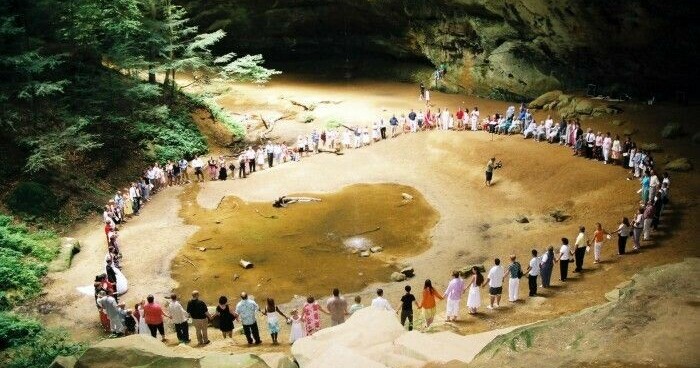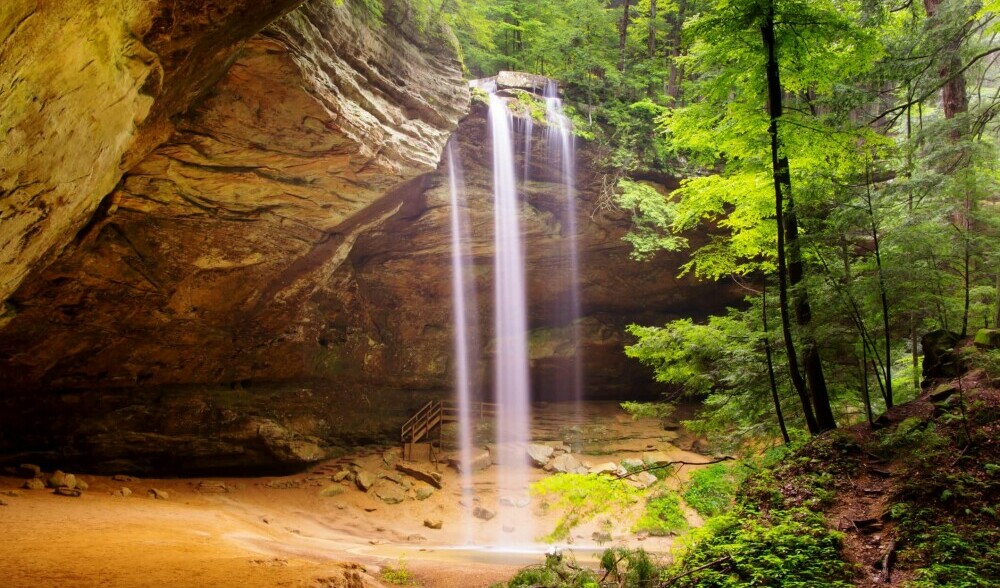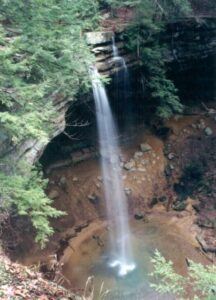If you’re craving a taste of nature’s sheer magnificence, look no further than Ash Cave in Hocking Hills, Ohio. Approximately 5 miles south of Old Man’s Cave, you’ll find this massive sandstone cavern nestled within the lush, rolling hills of the Hocking Hills region. Of the 6 major attractions at Hocking Hills State Park, Ash Cave is the furthest south.

Table of Contents
- Peering into the Past – The History Behind Ash Cave
- The Grand Scale of Nature – Exploring the Dimensions of Ash Cave
- Traversing the Trails – Hiking to Ash Cave
- General Park Information
As you traverse the relatively short path from the parking area toward the cave, it isn’t long before you are greeted with a spectacular and awe-inspiring view. It’s not just the sheer size of Ash Cave that grabs your attention; it’s also the intricate geological features that set it apart. Water cascades over the upper rim, feeding a small pool below, while the overhanging ledge provides shelter and an amphitheater-like setting that is very popular among visitors, musicians, and singing groups.
Ash Cave’s beauty and serene atmosphere have not only made it a popular destination for nature lovers and photographers, but many visitors even choose this majestic setting as the backdrop for their wedding vows.

Let’s step back in time a bit and discover how Ash Cave came to be such a treasured landmark with a strong connection to the past. The rich narrative waiting to be discovered teaches us more about the cave’s formation, use, and the intrinsic value it holds as part of Ohio’s storied landscape.
Peering into the Past – The History Behind Ash Cave

It’s believed that Native American tribes, including the Shawnee and others, frequented Ash Cave as far back as 7,000 years ago. They found shelter under its massive overhang and left behind a wealth of artifacts, from pottery shards to flint tools, which serve as a visceral connection to the past. The cave’s name itself is derived from the enormous heaps of ash found by early settlers, believed to be the remnants of ancient campfires.
European settlers stumbled upon the cave in the 1800s, quickly recognizing its value not just as a natural shelter but also as a community gathering place. Imagine folks from all walks of life, from preachers to politicians, flocking to Ash Cave for town meetings, church services, and even as a stop on the Underground Railroad.
Preservation has become a pivotal aspect of Ash Cave’s history in more recent times. In the mid-20th century, efforts to protect and maintain the integrity of this natural wonder gained momentum as awareness spread about the importance of conservation. Initiating state protection and creating Hocking Hills State Park, where Ash Cave is a highlight, ensured that future generations would continue to marvel at this chapter of Ohio’s natural history.
The Grand Scale of Nature – Exploring the Dimensions of Ash Cave

As Ohio’s largest recessed cave, Ash Cave boasts an overhanging ledge that is an impressive 700 feet from end to end. This natural amphitheater, with a semicircular rim soaring 90 feet above, cradles a horseshoe-shaped basin below.

If you’re curious about how such an awe-inspiring structure came to be, it’s all thanks to the erosion power of water. Millennia of rainfall percolating through sandstone carved out this recess, a process that continues to subtly shape the landscape even today. Inside the cave, the towering rear wall measures roughly 70 feet in height, further magnifying the sense of grandeur.
Walking into Ash Cave, you can’t help but feel dwarfed by its sheer scale. The cave’s floor stretches back 100 feet, offering ample space for visitors to marvel at its grandiosity. During your visit, don’t forget to look for the small waterfall that cascades over the rim and into a shallow pool below, adding to the cave’s enchanting atmosphere.
No matter what resonates most with you, whether it’s photography or simply enjoying tranquil moments in nature. Ash Cave provides a spectacular backdrop for both. Just imagine the panorama that unfurls before you as you stand at the cave’s open face – it’s a scene that stays with you long after your visit.

During winter, the massive horseshoe-shaped cave undergoes a captivating transformation and takes on a magical quality. The narrow gorge leading to the cave is adorned with stately hemlocks, beech trees, and other hardwoods, their branches dusted with snow or gripped by ice. As visitors venture along the trail, they encounter frozen waterfalls, their icy formations creating a serene and magical atmosphere. The small tributary of the East Fork of Queer Creek cascades over the rim, forming an ice cone below.
Traversing the Trails – Hiking to Ash Cave
Whether you’re a seasoned hiker or someone who simply enjoys leisurely strolls, there’s a path at Ash Cave suited for your pace. The primary Ash Cave Gorge Trail is a well-maintained, quarter-mile, ADA-accessible route that winds through towering hemlocks and across scenic streams to the cavern’s opening.

Along the way, interpretive signs shed light on the rich flora and fauna, making your journey to Ash Cave not only a visual treat but also an educational experience. For those looking for a bit more adventure, the longer, more challenging half-mile Rim Trail offers stunning views from above the cave.
But be sure to prepare before venturing out on any trails around Hocking Hills as the landscape can change quickly and unexpectedly. We recommend wearing a good quality hiking boot or shoe, use trekking poles to help navigate the challenging terrain, and always stay hydrated by drinking plenty of water with quality electrolyte supplement like LMNT!
A lot is happening very quickly in our natural world, and places like Ash Cave are precious. While enjoying the wonders of Ash Cave, remember that it’s not just a tourist destination; it’s a fragile ecosystem. Stick to the marked paths, carry out your trash (Leave No Trace), and respect the wildlife. This ensures that the cave and surrounding area remains unspoiled for generations to come.
In my opinion, the opportunity to connect with nature at Ash Cave is unparalleled. I really hope you take the opportunity to visit this incredible site and that your journey throughout Hocking Hills is as rewarding and memorable as the cave itself. Thanks for exploring with me, and I’d love to hear about your experience at Ash Cave—leave your comments below to share your story.
General Park Information
Park Location:
- Ash Cave
- 26400 OH-56, South Bloomingville, OH 43152
- GPS Coordinates: 39.40008043393649, -82.54340142543738
Hours:
- Half hour before sunrise to half hour after sunset.
Attributes:
- ?️Parking: Plenty with ADA spots available.
- ?Bathrooms: YES!
- ?Trash Cans: Dumpster in parking area.
- ?Dog Freindly: YES!
Trail Maps:
- Distance:
- Gorge Trail – Approx 1/4 mile
- Rim Trail – Approx 1/2 mile
- Overall Difficulty Rating:
- Gorge Trail – Easy
- Rim Trail – Moderate
- AllTrails Trail Maps:
- Ohio DNR Site
Upcoming Events:
Take Nothing But Pictures, Leave Nothing But Footprints, Kill Nothing But Time
** A bit of transparency: Our website contains affiliate links. When you click through and purchase a product or service through any of our links, we may receive a small commission. Don’t worry, there is no extra cost to you. It’s a simple way you can support our mission to keep Discovering Hocking Hills and bringing you quality content to make your escape to Hocking Hills unforgettable! **
